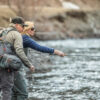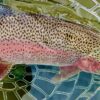Synopsis
The holiday season is upon us and it looks like we are entering an extended period of on and off wintery weather. In the short term, expect to see mostly cloudy skies and periods of snowfall. As a result, temperatures should be moderate, leading to more productive fishing and small emergences of Midges throughout our local systems. So bundle up in your winter weather clothing and take advantage of the open streams under our snowy skies.
The Big Wood, The Big Lost, and The South Fork of the Boise Rivers
Our local freestones and tail waters have undergone their transformation from fall to winter fisheries. The coldest days will bring ice flows which can make fly fishing difficult, if not impossible; however, even the coldest mornings usually give way to warmer afternoons as the solar radiation releases our rivers from the frigid grip of winter. During these warmer diurnal periods, the Midge will be the entomological star of the show. Otherwise known as the Snowfly, Midges can vary in size from minute to small (generally size 20-28).
Most often, the surface feeding patterns of winter fish will become present in the afternoons when the river temperatures are the warmest. Back eddies and slow water are often winter hot spots as rainbows will congregate in the deeper pools and runs where they can expend the least amount of energy while acquiring the greatest amount of protein. Fishing from pocket to pocket looking for high concentrations of fish is a productive way to approach the river. It is not uncommon to spend an hour or more in each of the larger holes as the conglomerations of fish can be significant.
Subsurface fishing tends to be the most effective method of trout fishing during the winter months. Many Midge imitations can be effective, such as Brassies in black, copper and red as well as midge pupa patterns in black, grey and red. Nymphing will also result in hookups if using Prince Nymphs, Flashback Pheasant Tails and Copper Johns in red, copper, silver, green and purple in sizes 14-18. Cranefly pupas such as Chamois are also effective along with Philo Betos, Woolly Buggers in green, black and brown and various streamers. Double nymph or nymph/midge pupa combinations in tandem with a strike indicator tend to be the most commonly used tackle selection. Since the trout will be lethargic due to the cold weather, light tippet (6X) is recommended when presenting these tiny insects, even the largest of fish will come to hand fairly quickly albeit on the lightest of line. It is important when playing fish in the depths of winter that great care is given to their release. It is best not to remove them from the water if at all possible and to handle them gently and briefly.
Silver Creek
The Creek will also offer good Midge fishing and due to its lower elevation, generally will offer slightly warmer air and water temperatures. However, if you drive south to fish, do remember that the Silver Creek Preserve is closed until the end of May. Try fishing the section north of Highway 20 where streamers and Woolly Buggers will be the most effective. Wade down the middle of the river, cast to the banks in a quartering-down fashion and strip your big bugs back toward you with short, quick motions as they swing to the center of the stream. Most large trout (rainbows and browns) will be hunkered down near or under the undercut banks and will be enticed to strike with a splashy presentation and the stripping of the fly. Although less subtle than dry fly presentations, streamer fishing in the abovementioned manner can lead to some remarkably aggressive strikes and massive wild fish!



